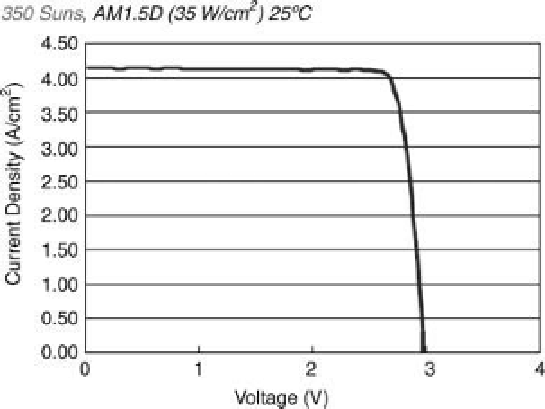Environmental Engineering Reference
In-Depth Information
Figure 7.4 Current
voltage curve of three-
junction GaAs cell under 350 terrestrial AM 1.5
sun illumination at 25 C. The open-circuit
voltage, in principle, approaches 1/e times the
sum of the bandgaps of the three junctions.
(Spectrolab press release. http://www.
spectrolab.com/DataSheets/TerCel/tercell.
pdf)
-
Cells of the type shown in Figure 7.3 are termed monolithic and are two-terminal
devices. It is evident that these complex devices are at a mature stage of development.
What is not clear is what cost levels would be attainable with such devices in mass
production. The complexity of the junction device is compounded, in an actual
system, with the need for high-accuracy optics, suggested by Figure 5.1, and with a
large and accurately tracking mirror or lens system suggested by Figure 5.8.
Nevertheless, it is argued that with high concentration the actual cell area needed
decreases to the point where the large installation could be cost-competitive with
larger area simple
flat plate cells such as those made by First Solar. Themanufacturer
Spectrolab says the tandemcells are useful both for point-focus concentrators and for
dense arrays and linear concentrators (Figures 7.4
-
7.6).
Figure 7.5 Measured efficiency as a function of
illumination strength, for cell similar to that
shown in Figure 7.3. A slightly different cell has
achieved 41.6%efficiency as opposed to the 30%
shown here. Note that the peak efficiency is
achieved at illumination on the order of 300
suns. (Spectrolab press release. http://www.
spectrolab.com/DataSheets/TerCel/tercell.pdf)


